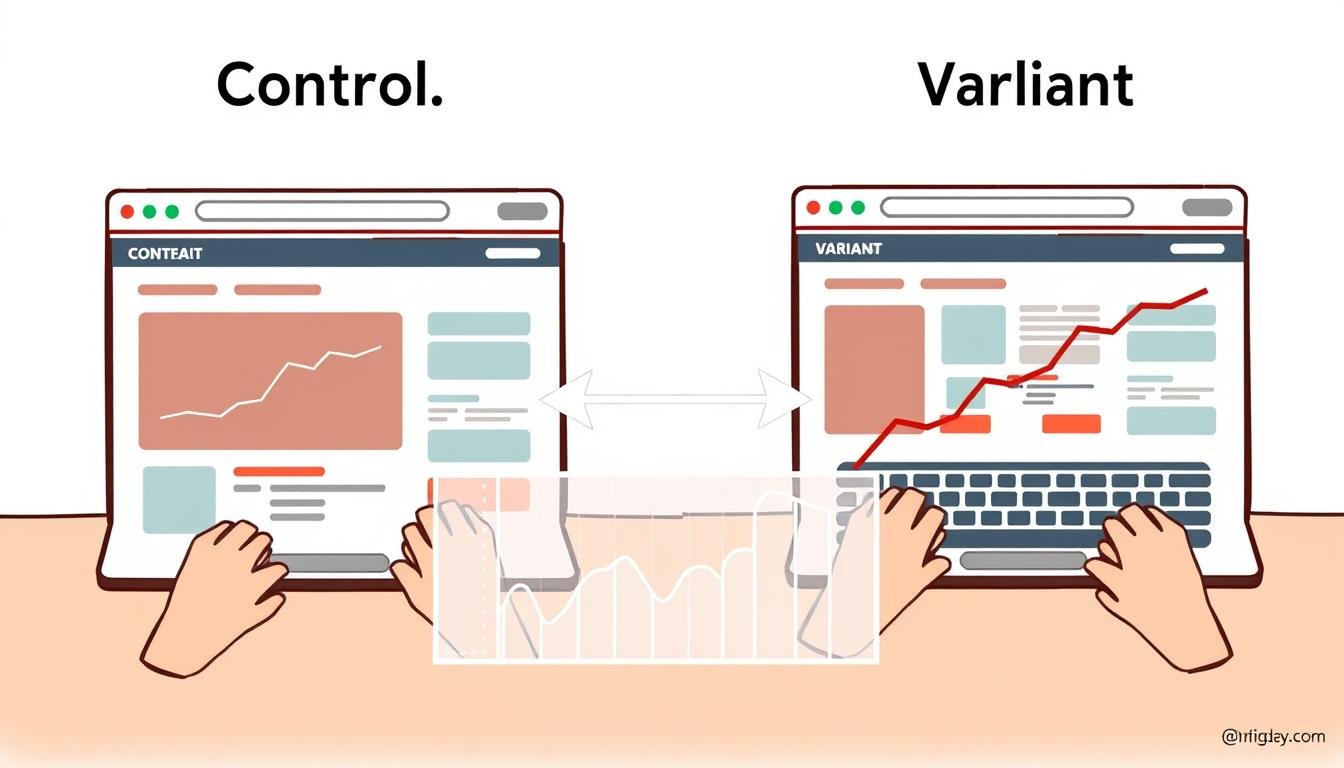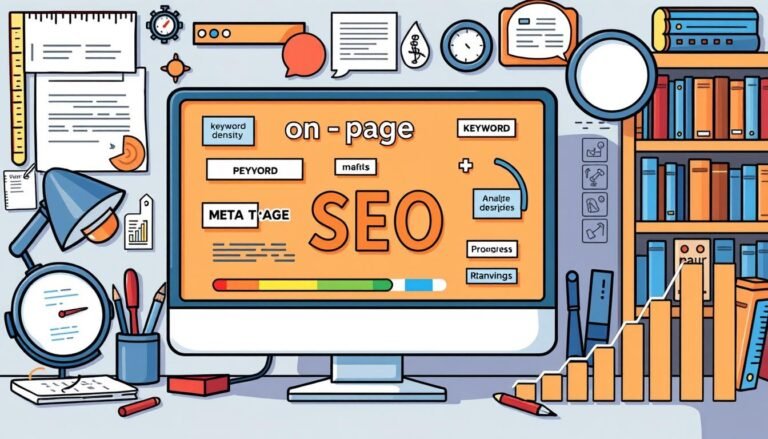How to Use A/B Testing to Improve Conversions
Did you know that about 60% of companies test their landing pages with A/B testing? This method is not just popular; it can boost conversion rates by up to 300%. A/B testing, also known as split testing, is key for digital marketers. It helps figure out which version of a webpage, app, or ad gets more conversions.
By testing two or more versions, marketers can make choices based on data. This leads to better user engagement and more revenue.
Using A/B testing strategies well helps marketers understand how people behave and improve their products. As we dive into how A/B testing can boost conversions, we see its importance. It’s essential for making websites better and meeting what users expect.
Key Takeaways
- A/B testing is a crucial method for improving conversion rates.
- Up to 300% improvement in conversions is possible through effective A/B testing.
- Understanding target audiences leads to better A/B testing outcomes.
- Incremental A/B testing helps minimize risks while enhancing rewards.
- Identifying clear goals is vital for successful A/B testing.
Understanding A/B Testing Basics
A/B testing, also known as split testing, is key in today’s digital marketing. It lets businesses test two versions of a webpage or email to see which one works best. This way, companies can improve their strategies and get better results.
What is A/B Testing?
A/B testing splits an audience into two groups. One group sees version A, the other sees version B. This helps businesses see which design, headline, or description gets better results. By looking at user actions, they can pick the better version, boosting engagement and performance.
This method is over 100 years old but has become very popular online in the last 20 years.
Importance of A/B Testing in Digital Marketing
A/B testing is very important. It lets businesses make choices based on data, not just guesses. By trying out different things, marketers can find what really grabs users’ attention. This can lead to more people opening emails and making purchases.
For example, small changes in email subject lines can make a big difference, increasing open rates by a lot. A/B testing can even double the number of customers from blogs.
How A/B Testing Drives Conversion Rate Optimization
Conversion rate optimization is a big goal for businesses. A/B testing helps them get the most from their website traffic. Even small tweaks can lead to a big jump in sales or leads.
This ongoing process lets brands keep improving their strategies. They can stay in tune with what users like and do, making sure their marketing hits the mark.
| Key Element | Impact of A/B Testing |
|---|---|
| Email Subject Lines | Increased open rates and subscriber engagement |
| Website Design | Improved bounce rates and user navigation |
| Call-to-Action (CTA) | Higher conversion rates through better user responses |
| Product Descriptions | Enhanced sales through tailored messaging |
| Content Variations | More effective engagement strategies |
How to Use A/B Testing to Improve Conversions
A/B testing can greatly increase conversions for businesses. It starts with clear goals that guide the testing. Knowing what to test helps marketers focus on key areas. Finally, understanding the results helps improve marketing strategies.
Setting Clear Goals and Objectives
Setting clear goals is key to success. Goals should be specific, measurable, achievable, relevant, and time-bound. For example, aiming for a 10% increase in conversions in two months sets a clear target. This focus helps teams know exactly what to do.
Choosing What to Test: Elements That Matter
Choosing what to test is crucial. You can test things like:
- Headlines and copy on landing pages
- Images and their positioning
- Call-to-action buttons, including color and size
- Length of forms in lead generation
- Pricing strategies for products
For example, using a red button in a call-to-action boosted conversions by 34%. Cutting an 11-field form to four fields increased lead form conversions by 160%. These changes show how small tweaks can make a big difference.
Interpreting A/B Test Results for Actionable Insights
Success in A/B testing means understanding the results well. Look at conversion rates, click-through rates, and engagement levels. When some tests do better than others, study them closely. For instance, removing navigation bars on landing pages doubled conversions from 3% to 6%.
| Test Element | Conversion Impact | Examples |
|---|---|---|
| Call-to-Action Button Color | 34% increase | Red vs. other colors |
| Form Fields | 160% increase | 11 fields vs. 4 fields |
| Navigation Presence | Doubled from 3% to 6% | Without navigation bar |
| Email Subject Line | 8% higher open rate | Value-driven lines |
Using this data helps build strong digital marketing strategies. It provides the tools to keep testing and improving.
A/B Testing Best Practices
Using A/B testing well means following best practices. These practices make results more accurate and effective. By focusing on specific user groups, you get better insights. This leads to better strategies.
Segmenting Your Audience for More Accurate Results
Segmenting your audience is key in A/B testing. It means dividing your audience by demographics, behavior, or preferences. This way, you can make tests that speak to specific users.
It leads to more precise results. It helps find out what drives conversions for different groups. For example, targeted campaigns can increase engagement, lower bounce rates, and boost returns.
Timing Your Tests: When and How Long?
Knowing when to test is crucial for getting reliable data. Test during busy times to see real user behavior. The length of your tests is also important.
Testing for a good amount of time gives you insights into various user behaviors. This makes the results more meaningful. It’s wise to test until you reach statistical significance to avoid jumping to conclusions too soon.
Documenting Results: A Case Study Approach
Recording A/B test results is key to a case study approach. By keeping detailed records, marketers can spot trends over time. This helps understand what works and what doesn’t.
This approach also encourages ongoing improvement. Regular reviews and updates based on data make A/B testing better over time. It helps increase conversion rates.
Tools for Effective A/B Testing
Using the right A/B Testing tools can boost your digital marketing strategy. Many popular options exist, each with unique features for marketers to improve conversion rates.
Top A/B Testing Tools and Software
Hotjar, VWO, Omniconvert, and Unbounce are top A/B Testing tools today. They offer different benefits for various testing needs:
| Tool | Key Features | Benefits |
|---|---|---|
| Hotjar | Customizable widgets, heatmaps, session recordings, surveys | Time-saving insights; improved understanding of user interactions |
| VWO | Statistics engine, heatmaps, multivariate testing | Quantitative and qualitative insights for effective decision-making |
| Omniconvert | Detailed A/B test reports, visitor behavior insights | Optimized website elements based on comprehensive analysis |
| Unbounce | Real-time reporting, landing page tests | Immediate feedback on conversion rates through targeted headlines |
Integrating A/B Testing with Analytics Tools
Linking A/B Testing tools with analytics platforms deepens your understanding of user behavior. Many tools offer features that connect testing outcomes with user interactions. Key benefits include:
- Comprehensive Insights: Better clarity on conversion metrics helps in refining marketing strategies.
- Visitor Behavior Understanding: Analyzing session recordings and heatmaps from tools like Hotjar provides context to A/B Test findings.
- Informed Decision-Making: Detailed reports from tools such as Omniconvert ensure that marketers act on concrete data.
- User-Centric Changes: Feedback from surveys enables understanding of user pain points and preferences.
The combination of A/B Testing tools and analytics tools integration is powerful. It helps optimize your digital marketing efforts effectively.
Conclusion
A/B testing is key in digital marketing. It helps improve website performance and boost conversions. By testing different versions of marketing assets, companies can find the best elements.
This method uses random traffic splitting and statistical analysis. It helps understand various testing types, like multivariate or split URL testing. This leads to better decision-making.
Marketers should keep testing and improving based on data. This is crucial for testing new features and making user experiences better. It directly affects conversion rates.
Using tools like Optimizely or VWO makes testing easier and more efficient. These tools help in optimizing marketing strategies.
So, A/B testing is essential for any digital marketing plan. It helps increase engagement and lower bounce rates. By doing this, businesses can improve their return on investment and create experiences that connect with their audience. This helps them stay competitive in the digital world.
Source Links
- 10 Guidelines To Improve The Effectiveness Of A/B Testing – Usability Geek
- What is A/B testing? A step-by-step guide with ideas & best practices
- Landing Page A/B Testing: The Ultimate Guide
- A Refresher on A/B Testing
- What is A/B Testing? A Practical Guide With Examples | VWO
- How to Do A/B Testing: 15 Steps for the Perfect Split Test
- 16 A/B Testing Ideas to Boost Conversions + Tools to Use
- A Guide to A/B Testing: How to Improve Conversion Rates?
- What Is A/B Testing? A Beginner’s Guide (Definition & Tips)
- A/B Testing Best Practices Can Save You Time, Money and Effort – Here’s How
- 7 A/B Testing Best Practices to Drive Greater Ad Performance | Lunio
- 6 Best A/B Testing Tools + Software
- The 16 best A/B testing tools and software alternatives to Google Optimize
- A/B Testing: A Guide You’ll Want to Bookmark
- The Ultimate A/B Testing Guide








